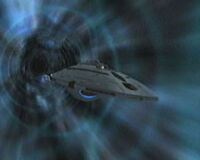
USS Voyager in slipstream
Quantum slipstream drive, also later known as transwarp slipstream drive, was an advanced form of transwarp drive. The USS Voyager obtained and tested slipstream drive technology in the 2370s (VOY: "Hope and Fear", "Timeless").
Function
Fan fiction
Though largely unsuccessful for Voyager, QSD became a major development in several fan fiction continuities.
Star Trek: Arcadia

UFS Arcadia in slipstream
In Star Trek: Arcadia, the Voyager transmitted their slipstream data to Starfleet in late 2376. By 2377 Starfleet R&D developed a slipstream drive vessel incorporating other innovative technologies, including a spatial deflector array, improved energy feeds and automated computer systems, which made stable slipstream transit possible. By the mid-2380s, continuous refinement of slipstream drive (scientifically known as reversible-field quantum restructuring quadraxial drive) enabled Quantum-class vessels such as the UFS Arcadia to reach speeds approximating warp 81,250. At maximum velocity, a non-stop, one-way trip using this form of QSD would cover the Milky Way Galaxy in roughly six months. Due to its tactical advantages, Starfleet closely guarded slipstream drive to prevent it from falling into hostile hands.
Star Trek: Defenders of the Federation
In Template:Dotf, like in Star Trek: Arcadia, the starship Voyager transmitted their slipstream data to Starfleet in late 2376. However in DOTF the study group assembled to study the data deemed that it was not possible for Starfleet to develop a working slipstream drive given the current level of technology. The study group did conclude that elements of the quantum slipstream drive technology could be implemented on existing Starfleet vessels to improve their warp capabilities. As a result the Prometheus was selected as a test-bed vessel and was refit to be able to project a low-power quantum field from its main deflector which, along with the tetryon warp plasma, resulted in the Prometheus 's cruising speed of warp nine and maximum speed of warp 9.99 requiring only two thirds of the amount of energy that was required to maintain the same speed prior to the qunatum field projection refit.
Star Trek: Interpreter
In Star Trek: Interpreter, the USS Interpreter was a prototype vessel fitted with the first Federation prototype quantum slipstream drive (sometimes referred to as quantum drive) in 2426. The research and development teams had thought they finally got it right after almost half a century working on it. The Interpreter on its maiden voyage tested its warp engines before docking but Captain Waters was a little hesitant with the slipstream drive.
Star Trek: Phoenix-X
In Star Trek: Phoenix-X, the USS Phoenix-X utilized slipstream torpedoes beginning around stardate 52339.1 (2375). A Romulan warbird, led by Plutark, intercepted a secret transmission of torpedo schematics between the Phoenix-X and Starfleet Intelligence. The Gordarions also obtained this technology from the Phoenix-X.
Star Trek: Pioneer (PNR)
In Template:PNR, the USS Pioneer became the first vessel to (officially) be fitted with a variant of quantum slipstream drive, known as transwarp slipstream drive, in 2388. However, the drive proved very unstable and not long after it was fitted the ship was thrown into the Triangulum Galaxy.
Star Triangle Advanced Guard
The Think Tank acquired slipstream technology from the USS Voyager. After being absorbed into the Council of STAG, the Think Tank along with the other members continued to improve on it until it was perfected in 2500. Soon after all major STAG starships were outfitted and both dartships, alphamorphs, and spheres were furnished with design specifications to create as the situation required. However it was rarely used after the creation of the STAG gateway. (STAG)
External link
Quantum slipstream drive article at Memory Alpha, the canon Star Trek wiki.
